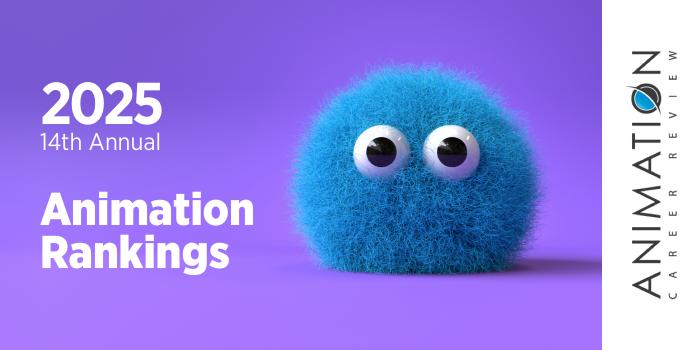
Start your career as a 2D animator for film, TV and games! CG Spectrum’s offers specialized online career training and mentorship from expert animators working at top studios. Get access to career services and a supportive community. Learn more.

| Ranking | School | City |
|---|---|---|
| 1 | University of North Carolina School of the Arts | Winston-Salem |
| 2 | North Carolina State University | Raleigh |
| 3 | East Carolina University | Greenville |
| 4 | University of North Carolina at Charlotte | Charlotte |
| 5 | University of North Carolina at Greensboro | Greensboro |
Our 2025 ranking -our fourteenth annual- of the top animation school programs in North Carolina. For an explanation of the ranking criteria, click here.

University of North Carolina School of the Arts (UNCSA) houses the School of Filmmaking and the School of Design and Production. Both schools provide paths to study animation. In the School of Filmmaking, students can earn an Animation BFA. The School of Design and Production houses an Animatronics concentration within the MFA program. Students in both programs will work and learn in a 100,000 square feet of state-of-the-art production space.
The Animation BFA program at University of North Carolina School of the Arts requires 120 credit hours of study including 84 in filmmaking; 30 in general education; and six in liberal arts of designated arts courses. The first year of the program focuses on courses such as Introduction to Animation I-II; Fundamentals of Production Design; Fundamentals of Screenwriting I-II; and Fundamentals of Picture Editing I-II.
At the end of the first year, students will complete a portfolio for entry into the full Animation program. Course examples include Storyboarding I-II; Computer Animation I-II; Computer Graphics I-II; International Animation; Sketching for Communication; Experimental Stop-Motion Animation; Life Drawing Studio; Advanced Computer Animation I-II; and Independent Study.
Third year students will complete a short, three-minute animated project and begin working on fourth-year projects. This culminating experience consists of a five-minute film that will serve as the BFA Thesis.
During the junior or senior year of the Animation BFA program, students also have the opportunity to complete an internship, along with upper-level elective courses to enhance the degree. UNCSA Animation BFA students have interned at major studios such as Cartoon Network, Sony Pictures Imageworks, Prologue Studios, and Stargate Studios.
Graduates are prepared to pursue positions in the entertainment industry, among others. Program alumni have landed full-time positions at Cartoon Network and Prologue Pictures. Some graduates have also gone on to launch their own independent studios and freelance businesses, while others pursue graduate study such as the School of Design and Production’s Animatronics MFA.
Launched in the Fall of 2021, the Animatronics MFA is a hybrid, three-year program that blends electronics and animation. The program emphasizes hands-on, immersive courses that explore the concepts, techniques, and tools used to create animated props and animatronic figures. Courses are supplemented by workshops, seminars, and screenings hosted by professionals in the industry.
Courses examples include Animatronic Programming; Figure Design and Engineering; Animatronic Design; Sculpting and Animatics; Production; 3D Design; and Prototypical Project Management.
The Animatronics MFA program at University of North Carolina School of the Arts culminates with a thesis project. Depending on the focus area, student’s thesis projects will highlight production, research, or a portfolio. Production Thesis students will present their finished work to the public. Research Thesis projects will be completed under the direction of a Thesis Supervisor.
Portfolio Thesis students will participate in the Portfolio Gallery Presentation, which showcases the student’s entire body of work. These fully documented portfolios will also include a Final Thesis Gallery Review. Graduates of the Animatronics MFA program at University of North Carolina School of the Arts go on to land positions at major studios such as Disney, Nickelodeon, ABC, Paramount Pictures, Universal Studios, LF Studios, and Animax.
University of North Carolina School of the Arts is America’s first public arts conservatory. Established in 1963 by the N.C. General Assembly, the school became part of the 17-campus University of North Carolina System in 1972. Today, UNCSA serves nearly 1,400 students enrolled in 40 degree programs across five schools. University of North Carolina School of the Arts is accredited by the Southern Association of Colleges and Schools Commission on Colleges (SACSCOC).

North Carolina State University (NC State) is home to the College of Design. Established in 1946 as the School of Architecture and Landscape Design, the College of Design provides dozens of degree and certificate programs in areas such as architecture, design, and media arts. Students in all areas will complete the College of Design’s interdisciplinary first-year experience along with workshops; swing studios in other majors; internships; and study abroad experiences in places such as Greece, Chile, and Prague.
Within the College of Design is the Department of Media Arts, Design and Technology (MADTech), which houses a Bachelor of Art + Design (BAD) and Masters of Art + Design (MAD) program. An Art + Design minor is also available. For this 15 credit hour program, students can select five courses from a list of pre-determined electives. Examples include Animation I; Visualizing Narrative; Sequential Imaging; Color and Light; Three-Dimensional Design; Drawing; and The Business of Art and Design.
All programs in the MADTech Department are highly multidisciplinary, allowing students to study both traditional disciplines and emerging techniques. Examples include animation; visual effects (VFX); graphic and interactive narratives; interactive and computational media; 3D modeling; virtual and augmented reality (VR/AR); and visual composition.
Electives provide additional opportunities to focus the BAD curriculum. Examples of required courses and elective options include Animation I-II; Digital Representation; Creative Technology Studio I-III; Digital Modeling; Art and Design International Studio; Visualization I-II; Color and Light; Advanced Digital Techniques; Art and Design Laboratory I-II; Drawing I-II; Writing About Film; Special Topics in Art and Design; Digital Motion; Sequential Imaging; and Digital Modeling.
Through a series of advanced studios, NC State BAD students will complete a final project and portfolio. Graduates are prepared to pursue careers in areas such as animation, filmmaking, game art and design, multimedia, illustration, and special effects-digital. BAD students can also pursue graduate studies at NC State (MAD program) or other top universities.
The Masters of Art + Design program at North Carolina State has three tracks. Track 1 consists of 30 credit hours; Track 2 requires 48 credit hours; and Track 3 consists of 72 credit hours. Track 1 is designed for students with a strong background in experimental and interactive arts. Track 2 is designed for students with an undergraduate degree in interactive and experimental media. These students are likely seeking initial studios to explore new theories and concepts for their final projects.
Track 3 is ideal for students who do not have a strong background in interactive and experimental media arts. Though these students may have a degree in another area, they will need to spend the first year taking advanced undergraduate courses.
All options provide the same opportunities to study animation as the BAD program, including a variety of elective options to enhance the degree. Examples include 3D Animation; Digital Modeling; Creative Coding; Seminar in Animation; Sequential Imaging; Visualizing Narrative; Special Effects; Digital Motion; and Business of Design.
For all MAD tracks, the final year provides the opportunity to produce a project in animation, interactive media, or other area. Students who choose not to complete a project may produce a research-based study or paper.
Graduates of the MAD program at North Carolina State University are prepared to pursue leadership positions in fields such as animation, filmmaking, game design, digital special effects, multimedia, illustration, and software design. Some program alumni go on to launch their own studios or freelance businesses, while others become art and design educators and researchers at leading colleges and universities.
North Carolina State University was established in 1887 as a land-grant institution focused on agriculture and engineering. Today, the school is a leader in science, technology, engineering, and math (STEM). With 9,000 faculty and staff members, NC State serves more than 36,000 students, making it the largest university in the University of North Carolina System and one of the largest employers in the state.
Students at NC State have access to more than 300 degree programs across 12 colleges, 68 departments, and The Graduate School. North Carolina State University is accredited by the Southern Association of Colleges and Schools Commission on Colleges (SACSCOC).

East Carolina University’s College of Fine Arts and Communication is home to the School of Art and Design (SoAD). Housed in the Leo W. Jenkins Fine Arts Center and accredited by the National Association of Schools of Art and Design (NASAD), the SoAD provides a flexible Art BFA program with 11 concentrations. Examples include Animation and Interactive Design; Illustration; Film and Video Production; Drawing; Graphic Design; and Painting. Concentration areas require 30 credit hours.
The SoAD ECU Animation and Interactive Design concentration explores areas such as 2D animation, game design, creating digital environments, interaction design, video art, and character design. Students in this concentration will work and learn in 150,000 square feet of space that houses digital classrooms; the film and media studio; computer labs; drawing and painting studios; the Image Creation and Output Resource (ICOR) Lab; and dedicated BFA studios with 24/7 access.
Students in all SoAD concentrations will complete general education courses such as Introduction to Philosophy of Art, and Art History Survey. All students will also complete common core courses such as Form, Space, and Color; Process in Studio Arts; American and International Film History; Topics in Multidisciplinary Art; Visual Organization; Narrative in Art and Design; Drawing; and Translation as Making.
The Animation and Interactive Design concentration at East Carolina University includes courses such as Introduction to Digital 3D Modeling and Animation; Narrative Through Kinetic Imaging; Introduction to Interactive Design; Animation Production Studio; Digital 3D Lighting and Rendering; Animation and Interactive Design Survey; Professional Practice; Motion Design Studio; Advanced Interactive Design; and Digital 3D Animation.
Coursework for the concentration is supplemented with activities led by the Animation and Interactive Design Guild. Guild activities include travel to conferences; support on creative projects; research opportunities; visiting artists talks; and workshops. Students in all Art BFA concentrations also benefit from hands-on learning; partnerships with local arts organizations; internships; access to career development services; and study abroad experiences.
All ECU Animation and Interactive Design students will complete a final project and portfolio and participate in the Senior Exhibition. This culminating experience prepares students to pursue professional roles in areas such as animation, games, film production, interactive design, television, architecture, advertising, marketing, web design, science, medicine, healthcare, and research.
East Carolina University was chartered as East Carolina Teachers Training School in 1907. Part of the University of North Carolina System of 17 institutions, the school serves 27,785 students, making it one of the top five largest universities in North Carolina. Programs include more than 270 degrees and certificates housed across numerous colleges and schools. East Carolina University is accredited by the Southern Association of Colleges and Schools Commission on Colleges (SACSCOC).

University of North Carolina at Charlotte (UNC Charlotte or Charlotte) is home to the College of Arts and Architecture (COA+A). Serving 1,000+ students, the college provides more than 30 degree programs and concentrations. Within the COA+A is the Department of Art and Art History. Launched in 1964 as the “Fine Arts Program,” the department houses more than a dozen undergraduate options. Across programs, students benefit from real-world, immersive experiences through internships, community programs, research, and more than 100 events each year.
For students seeking an animation degree, the Department of Art and Art History has an Art BFA with a Digital Media concentration. This professional degree program requires 120 credit hours, with 79 in the major and 30 in the concentration. This includes advanced studio courses such as Animation Production; Digital Compositing; 3D Modeling and Animation; Interactive Art and Design; Game Design and Graphics; Advanced 3D Modeling and Digital Fabrication; UX/UI Design Strategies; Topics in Digital Media; and Video Art.
All Art BFA students will complete the Senior Experience, which consists of Senior Seminar; Senior Thesis I: Creative Research; and Senior Thesis II: Advanced Creative Projects or Illustration Projects. Courses culminate with the Senior Exhibition (BFA Thesis Show). Graduates will leave the program with a professional portfolio of their best work.
UNC Charlotte Art BFA/Digital Media alumni are prepared to pursue careers in areas such as animation, film and video, game art and design, television, multimedia design, architecture, UX/UI design, advertising, and web design. Graduates are also prepared to pursue graduate studies or launch their own independent design studios and freelance businesses.
Founded in 1946 and serving approximately 31,090 students, University of North Carolina at Charlotte is the third largest school in the 16-campus UNC System. Students at this public research university have access to more than 240 majors and degree programs housed across 10 colleges and schools. University of North Carolina at Charlotte is accredited by the Southern Association of Colleges and Schools Commission on Colleges (SACSCOC).

University of North Carolina at Greensboro (UNC Greensboro or UNCG) is home to the College of Visual and Performing Arts (CVPA). Dating back to the 1890s, the CVPA houses the largest number of art programs in the UNC System. Within the CVPA are the Schools of Art, Dance, Music, and Theatre.
Across schools, students have access to programs accredited by the National Association of Schools of Art and Design (NASAD); the National Association of Schools of Dance (NASD); the National Association of Schools of Music (NASM); and the National Association of Schools of Theatre (NAST). The CVPA is also a member of the University Resident Theatre Association (U/RTA).
The CVPA School of Art provides a Studio BFA with an Animation concentration. For entry into the BFA program, students will apply as a first year BA student and enter the Foundations Program (FP). The year-long FP consists of courses that explore drawing, design, and sculpture. Examples include Three-Dimensional Foundations I-II; Intermediate Drawing; Foundation Design I-II; Foundations Seminar; Survey of Western Art I-II; and Drawing I.
Upon successful completion of the Foundations Program, students will submit a portfolio of 16 works for review and consideration for the BFA program. This studio-intensive pre-professional degree consists of 120 credit hours and courses such as 2D Animation; Life Drawing; Introduction to 3D Animation; Concept Art; Storyboarding for Animation; Introduction to Digital Modeling; Analysis of Global Animation; Sequencing; and Advanced Animation.
The Animation concentration requires 42 credit hours of study, including the culminating experience for the program—the Animation Capstone. Completed across two courses, this final project consists of an industry-ready film, promotional materials, and an individual portfolio highlighting work completed on the production. Final and other projects for the program take place in the School of Art Animation Lab in UNCG’s Gatewood Studio Arts Building.
Graduates of the UNC Greensboro Art BFA/Animation program are prepared to pursue an advanced degree or careers in fine arts, animation, concept art, motion graphics, communications, or media art. Some program alumni have also launched their own independent studios or freelance businesses.
Founded in 1891, University of North Carolina at Greensboro is one of the original three UNC System institutions. Serving approximately 18,015 students, the school provides more than 350 areas of undergraduate and graduate study across nine colleges and schools. The University of North Carolina at Greensboro is accredited by the Southern Association of Colleges and Schools Commission on Colleges (SACSCOC).